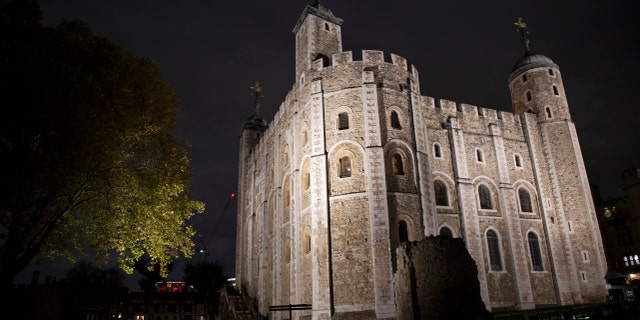No products in the cart.
The skeletons of a woman and child have been discovered in the Tower of London, the first skeletons found at the famous historic site in 50 years.
The fortress, which is nearly 1,000 years old, is infamous as a former prison and site of execution for those found guilty of treason. Two of the six wives of King Henry VIII, Anne Boleyn and Catherine Howard, were beheaded in the Tower complex.
In a blog post, Alfred Hawkins, historic buildings curator for Historic Royal Palaces, which oversees the Tower of London, explained that the skeletons of the unknown woman and child were uncovered earlier this year. Archaeologists spotted them when they were excavating outside the entrance to the Tower’s Chapel of St. Peter ad Vincula.
ARCHAEOLOGISTS UNCOVER THE LOST ROYAL PALACE OF HENRY VIII

Historic Royal Palaces curator Alfred Hawkins inspects one of the skeletons uncovered at the Tower of London
(Historic Royal Palaces)
The excavation, which was part of a project to improve access to the chapel, found the remains of a woman who was aged between 35 and 45 at the time of her death, and the skeleton of a 7-year-old child.
“These remains were found lying on their backs facing up (or ‘supine’) and were aligned with their feet facing east,” explained Hawkins in the blog post. “Due to the presence of coffin nails, and the positioning of the skeletons, it is thought that the adult female was buried within a coffin while it is likely the child was simply wrapped in a blanket (‘shrouded’) prior to being buried.”
HISTORIAN DISCOVERS SECRET NOTES HIDDEN IN 500-YEAR-OLD BIBLE
The skeletons, which are thought to have been buried between 1450 and 1550, were interred without burial goods and there were no signs of violent deaths.
Analysis of the bones, however, showed that both the woman and child endured difficult lives. “Both skeletons show signs of illness and the adult shows signs of chronic back pain. Their growth shows not a comfortable life, but one which is typical of the period in which they lived,” wrote Hawkins.

The skeletons are thought to have been buried between 1450 and 1550. (Historic Royal Palaces)
The curator explained that, while the Tower of London’s role as a prison and site of executions is well known, the castle was also home to a thriving community of people. “This fortress has been occupied for nearly 1,000 years, but we must remember it is not only a Palace, Fortress and Prison but that it has also been a home to those who worked within its walls,” he wrote.
The skeletons were found in a layer of centuries old-mortar that experts think may be part of the floor of King Edward I’s “lost chapel,” which burnt down in 1513.
BIZARRE MEDIEVAL ‘TRIPLE TOILET SEAT’ REVEALED
“This building was previously thought to be located in a different position, and due to this discovery our understanding of the evolution of the Chapel of Saint Peter ad Vincula has been completely altered,” Hawkins wrote.

The skeletons were discovered during an excavation at the Tower’s Chapel of St. Peter ad Vincula.
(Historic Royal Palaces)
Live Science reports that the skeletons are the first human remains to be found at the Tower of London since the 1970s. The excavation was featured in an episode of the series “Inside the Tower of London,” which aired on Channel 5 in the U.K. earlier this week.
The skeletons were reburied in the Chapel of St. Peter ad Vincula in a special ceremony on Sept. 10, 2019.
MEDIEVAL SKELETON UNEARTHED IN LONDON WEARING ‘EXPENSIVE’ LEATHER BOOTS

Night view of the White Tower at the Tower of London.
(Mike Kemp/In PIctures via Getty Images)
London continues to reveal new aspects of its rich history. The long-lost remains of Captain Matthew Flinders, the explorer credited with giving Australia its name, were discovered near a London railway station earlier this year. And in 2017, archaeologists uncovered the remains of Greenwich Palace, the birthplace of Henry VIII and Elizabeth I.
CLICK HERE TO GET THE FOX NEWS APP
In 2016, a historian discovered secret notes hidden in the text of England’s first printed Bible. The Latin Bible, which was published in 1535 by Henry VIII’s printer, revealed fascinating English annotations made during the 16th-century Reformation. Housed in the library of Lambeth Palace, which is the official London residence of the Archbishop of Canterbury, the Bible is one of just seven surviving copies.
Follow James Rogers on Twitter @jamesjrogers


